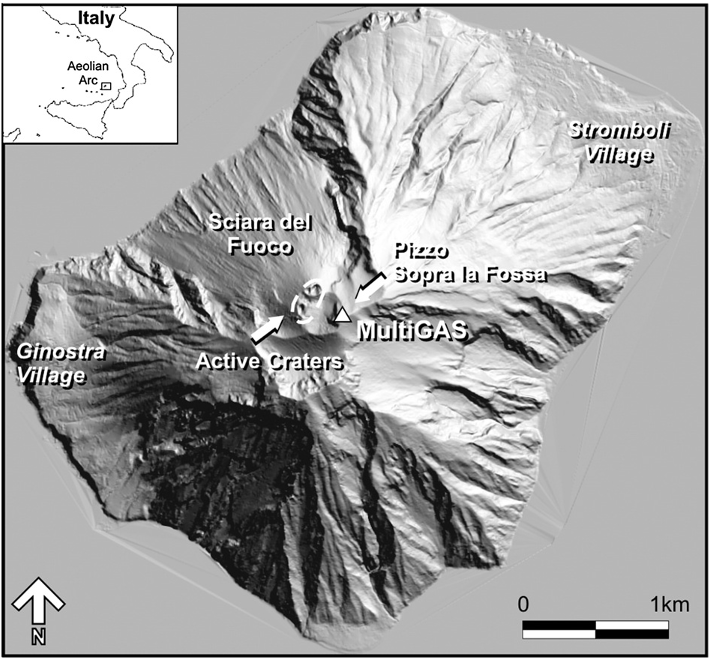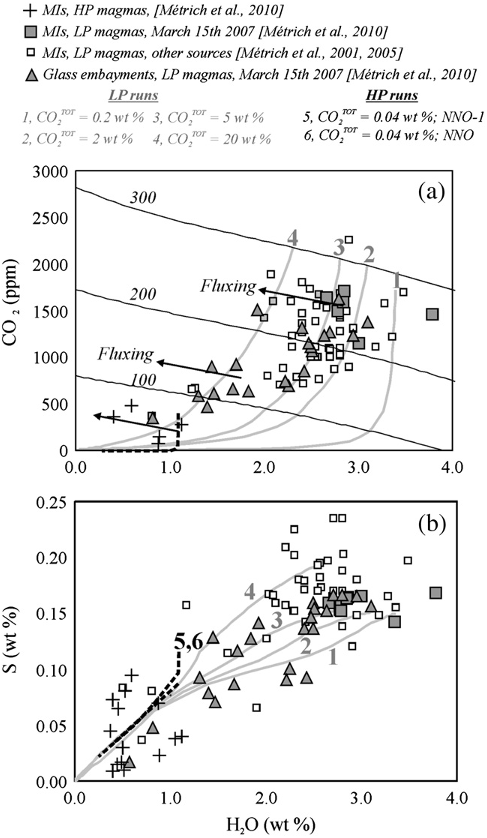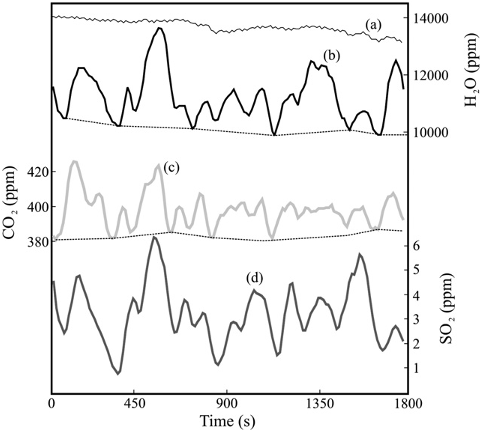A model of degassing for Stromboli volcano
Alessandro Aiuppa,Antonella Bertagnini,Nicole Métrich,Roberto Moretti,A. Di Muro,Marco Liuzzo,Giancarlo Tamburello +6 more
TLDR
In this article, the authors used the MultiGAS technique to provide the best documented record of gas plume discharges from Stromboli volcano to date, and showed that Strombolian's gases are dominated by H2O (48−98−mol); mean, 80%), and by CO2 (2−50−mol%; mean, 17%) and SO2 (0.2−14−mol; mean, 3%).About:
This article is published in Earth and Planetary Science Letters.The article was published on 2010-06-15 and is currently open access. It has received 144 citations till now. The article focuses on the topics: Strombolian eruption & Volcanic Gases.read more
Figures

Fig. 6. Schematic cross-section showing the main features of Stromboli's crustal plumbing system (modified from Métrich et al., 2010). See text for discussion. 
Fig. 1. A map of Stromboli showing the location of the permanent MultiGAS on Pizzo Sopra la Fossa. 
Fig. 7. Volatile abundances in Stromboli's melt inclusions and glass embayments contrasted against results of the saturation model. Data fromMétrich et al. (2001, 2005, 2009) and Bertagnini et al. (2003). (a) H2O vs. CO2; (b) H2O vs. S. The grey solid lines are model results from LP runs 1–4, whilst black dashed lines show model results from HP runs 5–6. Comparison of natural and modelled compositions confirms that the deep (PN100 MPa) LP magma contains a high (2–5 wt.%; model curves 2–3) fraction of gas bubbles at reservoir conditions. Glass embayment formed at P∼100 MPa are H2Opoorer than predicted by model curves 2–3, suggesting some extent of gas fluxing with CO2-rich gas bubbles. This triggers de-hydratation of the LP magma, and probably controls transition to HP magma. The same process likely occurs also in the upper conduit system (compare model trends 5–6 with volatile abundances in HP magmas). In a, isobars are traced under a fixed Fe2/Fetot ratio of 0.24 (Table 2), and are thus slightly different than those originally reported byMétrich et al. (2010) (who, yet using the same saturation model, used a constant ΔNNO value, thus yielding variable Fe2/Fe3 proportions depending on melt composition, and water particularly). 
Table 1 Compositions of Stromboli's volcanic gas plume (in mol%). We derive compositions for both the bulk plume (essentially contributed by persistent passive degassing) and the syn-explosive plume (the gas jet of a Strombolian explosion, reaching the MultiGAS a few seconds after the burst, and before being diluted in the main plume). 
Fig. 2. An example of a 1800 sMultiGAS acquisition at Stromboli (acquisition frequency, 9 s). Whilst small erratic variations of H2O concentrations are typically measured when the plume is condensing (curve a), more systematic variations (curve b) are observed in dry weather conditions and when the plume fumigates the Pizzo Sopra la Fossa area. These are correlated with variations of CO2 (curve c) and SO2 (curve d) concentrations. In such circumstances, volcanic H2O was derived from the raw data (b) by subtracting background air H2O content; this required fitting a polynomial function (shown as a dotted line) to H2O measurements for which a SO2 content of nearly 0 was consistently detected. 
Table 2 List of input parameters of model runs. LP runs simulate isothermal closed system ascent of LP magmas (melt composition data Métrich et al., 2010) within their storage zone (300– 190 MPa pressure range), and upon shallow emplacement (down to 100 MPa). Redox conditions along the decompression path were fixed by the Fe2+/Fe3+ buffer, for which we adopted the value of 3.4. This choice is based on XANES determinations on a hydrous (H2O=2.9 wt.%) LP magma melt inclusion (Bonnin-Mosbah et al., 2001), but is also consistent with the olivine-liquid iron and magnesium partition observed in a large set of Stromboli MIs (Bertagnini et al., 2003). The resulting logfO2 conditions range from 0.07 to 0.82 NNO (NNO is the Nickel–Nickel Oxide buffer). Note that while MI compositions can be taken as good proxies for total (exsolved+dissolved) water and sulphur contents (then evaluated as H2OTOT: 3.4 wt.%; STOT: 0.16 wt.%, respectively), LP magmas were probably already saturated with a CO2-rich gas phase when the most primitive MIs formed. If such, the highest measured dissolved CO2 content (∼0.2 wt.%; see Fig. 7a) in MIs would significantly underestimate CO2TOT. Four separate LP runs (with different CO2TOT contents; these should be viewed as CO2 concentrations in the magma, i.e., in the melt plus gas suspension) were thus carried out. As for HP runs, we considered a shoshonitic melt with total CO2, H2O, and S contents of 0.04, 1.2 and 0.1 wt.%, respectively (as from representative compositions of MIs in olivines from erupted HP products; Métrich et al., 2010). The recurrent observation of a sulphide immiscible liquid phase in MIs suggests that the HP magma is potentially in a more reducing redox state than the LP magma; we therefore performed model runs at both NNO at NNO-1 redox conditions. For both LP and HP runs, melt composition data are from Métrich et al. (2010).
Citations
More filters
BookDOI
Carbon Dioxide Emissions from Subaerial Volcanic Regions: Two Decades in Review
Cynthia Werner,Tobias Fischer,Alessandro Aiuppa,Marie Edmonds,Carlo Cardellini,Simon Carn,Giovanni Chiodini,Elizabeth Cottrell,Mike Burton,Hiroshi Shinohara,Patrick Allard +10 more
TL;DR: In this article, the authors quantify the current volcanic flux of carbon to the atmosphere and understand the factors that control this flux, which is of fundamental importance for stabilization of atmospheric CO2 and for long-term climate.
Journal ArticleDOI
Generation of CO2-rich melts during basalt magma ascent and degassing
Michel Pichavant,Michel Pichavant,Ida Di Carlo,Silvio G. Rotolo,Silvio G. Rotolo,Bruno Scaillet,Bruno Scaillet,Alain Burgisser,Nolwenn Le Gall,Nolwenn Le Gall,Caroline Martel,Caroline Martel +11 more
TL;DR: In this paper, the authors stress the importance of bubble nucleation and growth, and of volatile diffusivities, for basaltic melt degassing, and show that CO2-oversaturated melts can be generated as a result of magma decompression.
Journal ArticleDOI
Hydrogen in the gas plume of an open‐vent volcano, Mount Etna, Italy
Alessandro Aiuppa,Alessandro Aiuppa,Hiroshi Shinohara,Giancarlo Tamburello,Gaetano Giudice,Marco Liuzzo,Roberto Moretti +6 more
TL;DR: In this article, the first hydrogen determinations in the volcanic gas plume of Mount Etna, in Italy, were obtained during periodic field surveys on the volcano's summit area with an upgraded MultiGAS.
Journal ArticleDOI
Overview of the precursors and dynamics of the 2012-13 basaltic fissure eruption of Tolbachik Volcano, Kamchatka, Russia
TL;DR: In this article, a broad overview of the 2012-13 flank fissure eruption of Plosky Tolbachik Volcano in the central Kamchatka Peninsula is presented, which lasted more than nine months and produced approximately 0.55 km3 DRE (volume recalculated to a density of 2.8 g/cm3) of basaltic trachyandesite magma.
Journal ArticleDOI
Thermal, Deformation, and Degassing Remote Sensing Time Series (CE 2000–2017) at the 47 most Active Volcanoes in Latin America: Implications for Volcanic Systems
K. Reath,Matthew E. Pritchard,Michael P. Poland,Francisco Delgado,Francisco Delgado,Simon Carn,Diego Coppola,Benjamin J. Andrews,Susanna K Ebmeier,E. Rumpf,S. T. Henderson,S. Baker,Paul Lundgren,Robert Wright,Juliet Biggs,Taryn Lopez,Christelle Wauthier,S. Moruzzi,A. Alcott,Rick L. Wessels,Julia P. Griswold,Sarah E. Ogburn,Susan C. Loughlin,Franz J. Meyer,G. Vaughan,Marco Bagnardi,Marco Bagnardi +26 more
TL;DR: In this article, a comparison of multi-satellite time-series on a regional scale provides information regarding volcanic behavior during, non−, pre−, syn− and post−eruptive periods.
References
More filters
Journal ArticleDOI
The compositional dependence of the saturation surface of H2O + CO2 fluids in silicate melts
TL;DR: Papale et al. as mentioned in this paper applied thermodynamic equilibrium between gaseous and liquid volatile components to model the volatile saturation surface in H 2 O−CO 2 -silicate melt systems.
Journal ArticleDOI
Volatile Abundances in Basaltic Magmas and Their Degassing Paths Tracked by Melt Inclusions
Nicole Métrich,Paul J. Wallace +1 more
TL;DR: The abundances of CO2, H2O, S and halogens dissolved in basaltic magmas are strongly variable because their solubilities and ability to be fractionated in the vapor phase depend on several parameters such as pressure, temperature, melt composition and redox state as mentioned in this paper.
Journal ArticleDOI
Melt inclusion record of the conditions of ascent, degassing, and extrusion of volatile-rich alkali basalt during the powerful 2002 flank eruption of Mount Etna (Italy)
TL;DR: In this article, the authors decipher the origin and mechanisms of the second eruption from the composition and volatile (H2O, CO2, S, Cl) content of olivine-hosted melt inclusions in explosive products from its south flank vents.
Journal ArticleDOI
Petrologic Reconstruction of Magmatic System Variables and Processes
Jon D Blundy,Kathy Cashman +1 more
TL;DR: In this article, the authors present some of the current petrological techniques that can be used for studying eruptive products and for constraining key magmatic variables such as pressure, temperature, and volatile content.
Journal ArticleDOI
Magmatic Gas Composition Reveals the Source Depth of Slug-Driven Strombolian Explosive Activity
Mike Burton,Mike Burton,Mike Burton,Patrick Allard,Patrick Allard,Patrick Allard,F. Murè,F. Murè,F. Murè,Alessandro La Spina,Alessandro La Spina,Alessandro La Spina +11 more
TL;DR: Spectroscopic measurements performed during both quiescent degassing and explosions on Stromboli volcano are used to demonstrate that gas slugs originate from as deep as the volcano-crust interface (∼3 kilometers), where both structural discontinuities and differential bubble-rise speed can promote slug coalescence.